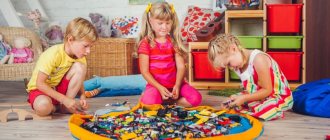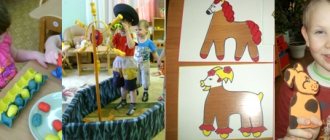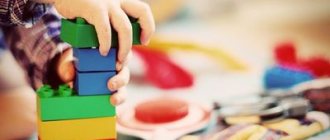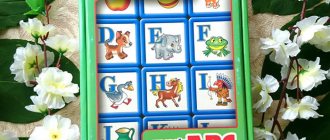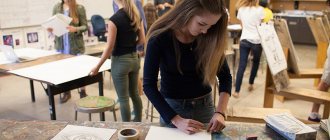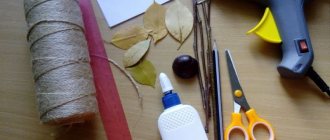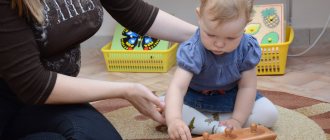Basic principles of teaching a 2 year old child
Parents do not always have the opportunity to send their child to kindergarten from the age of two. In such cases, it is recommended to organize training and creative activities at home yourself. It is important to note that all exercises must be performed in a playful manner. It is strictly forbidden to force children to do something without desire. This can completely discourage you from learning in the future.
Classes from 2 years old
Classes for children aged 2-3 years are very easy to organize on your own. For this purpose, there are a huge number of educational games and didactic materials that allow you to diversify your activities. Any activity should be bright, interesting, and deliver only positive emotions. Children immediately lose interest as soon as they realize that they are forcing them.
Games and activities to develop sensorimotor skills
What's new at this age:
- We play with clothespins (we attach clothespins to templates, transfer pieces of foam rubber using clothespins);
- Winder games;
- Making soap foam (learning to whisk, blowing bubbles through a straw);
- We find objects in the bag by touch;
- We learn to organize objects, focusing simultaneously on color and size, or color and shape;
An example of a toy suitable for this is cylinders (Labyrinth, My-shop, KoroBoom)
- We play with nuts (remember their names, sort them by type, take them out of the bag by touch);
- Playing with tweezers;
An example of baby tweezers and other useful tools for motor development
- Playing with sensory boxes;
- We play with a knocker (with nails);
Example of a knocker: Ozon, My-shop, Babadu
- We assemble the nesting doll by combining the pattern on its parts;
Example of a nesting doll: Labyrinth, My-shop, Daughters & Sons
- We assemble puzzles from 4-20 parts;
Puzzle example: Ozon, Labyrinth, My-shop
- We find the missing fragments on a homemade puzzle;
- We do finger exercises with finger toys;
Example of finger toys: Ozon, My-shop, KoroBoom
- We select bolts and nuts according to size and fasten them;
- We select the keys to the locks;
- Place pasta/buttons along the lines;
- We play with a pipette, pouring water into the cells; we play with a rubber bulb and a dispenser;
Example of a pipette
- Cut with scissors;
Example of notebooks for cutting - Kumon: Labyrinth, My-shop, Ozon
- Playing with construction sets;
Here you can find a selection of construction sets for children aged 2 years and older; and here are options for the first buildings made from cubes.
- We construct from counting sticks;
- We play with a lacing tablet;
Lacing example: Ozon, KoroBoom, My-shop
- Playing with kinetic sand;
Example of kinetic sand (Ozon, My-shop)
Already familiar games:
- We build paths from dominoes;
- Pour water from one bowl to another using a sponge;
- We make a picture using puzzle cubes;
We try options from 4 cubes: Ozon, Labyrinth, My-shop
and from 9 cubes: Ozon, Labyrinth, My-shop
- We play with two or three-layer frame inserts;
Example of three-layer and two-layer puzzles
- We play fishing with pyramid rings;
- We select lids for jars;
- We play with inset frames without background pictures;
Examples of frames: Labyrinth, My-shop, KoroBoom
- We play magnetic fishing;
Examples of fishing: Ozon, KoroBoom, My-shop
- We play mosaic;
Examples of the first mosaics: Ozon, Labyrinth, My-shop
- We open and close boxes with different closing/latching options;
- We learn to open and close locks, latches, etc.;
An example of a board with locks (My-shop, KoroBoom) or a busy board
- Pour water from the teapot into glasses;
- Sift the cereal through a strainer;
- We cut vegetables and fruits;
Example of a set of vegetables (Ozon, My-shop, Labyrinth)
- We play lotto;
- Picking mushrooms/berries;
- We dress the dolls by putting on clothes;
Examples of kits for dressing dolls (Ozon, My-shop)
- Roll the ball/ball along the slide/grooves;
An example of a bowling alley (Ozon, Labyrinth, My-shop)
- Peel the boiled egg;
- We learn to unfasten Velcro, zippers, unscrew and tighten bottle caps;
Examples of toys useful in this matter:
DIY educational mat
Book “I dress myself” (Ozone, Labyrinth, My-shop)
Board with fasteners (My-shop, KoroBoom)
A two-year-old child and the peculiarities of his thinking
Psychologists say that the second year of life for children is a period of crisis. They begin to actively study the world around them and realize the difficulties it can bring them.
On a note! The task of parents is to help the child overcome the crisis period.
Parents often make a big mistake, believing that at two years old it is not worth teaching a child anything, since he will not understand. But when they begin to raise him, it turns out that time is lost. In the first five years of a child’s life, the foundations of education are laid. The most important years are considered to be 1.5-2.
At the age of two years, the child should speak. Thanks to this, the development of his self-awareness accelerates. It is through speech communication that he receives most of the information that is necessary for development. It is important for parents to pay as much attention as possible to speech formation during this period. At the age of one and a half years, the baby already knows how to call a spade a spade. By the age of two, he already develops the ability to combine up to three words into a phrase.
Important! When a child reaches his third year, his thinking changes from visual-effective to visual-figurative. It differs in that all actions with material objects are replaced by images. The internal development of thinking is based on the formation of concepts.
By the end of the second year, children begin the “why” period. The child becomes persistent, he demands an answer to the question posed. The attitude towards the answer received is already expressed. At three years old, the child begins to see himself from the outside; he is already able to control his behavior.
Features of development
Role-playing games
Ideas for simple story games can be found here and here. From about 2 years old, a child becomes interested not only in watching the scenes that you show him, but also in participating in them himself. Therefore, invite your child to take on some role during the game. Act out simple fairy tales (turnip, bun, hen, etc.).
Developmental activities at home with mom, exercises for every day
The task of parents is to spend as much time as possible with the child and organize his leisure time. First of all, you need to start classes with hand motor skills. It is necessary to get your child interested in building houses from cubes. You should start with the simplest figures, gradually increasing complexity. It is important to constantly talk to the children during the game and explain every action of the owl. There must be praise.
Children aged two to three years show great interest in household chores. Don't discourage yourself from helping your mom. You can invite your baby to sweep or wipe off the dust themselves. You should always invite your child to help their parents. If you don’t do this, you will have to force him at an older age.
Some parents prefer to hire professional nannies to work with their children. This is a big mistake. At an early age, a baby really needs to communicate with his mother. Any exciting game unites and brings parents and children closer together. It is very useful to play with the whole family.
Important! It is recommended not just to select activities, but to focus on the child’s specific abilities. It is best to alternate creative games with active ones. It is important to observe the time of the classes; they should be no more than twenty minutes. It is still very difficult for children to concentrate on one subject for a long time.
Drawing lesson on the topic “Professions” for middle groups of preschool educational institutions
Activities with mom
Developing baby's speech
At two years old, a child not only knows the name of an object, but also knows how to describe it. It is necessary to develop his skills, describe color, size. It is important during this period to pay as much attention as possible to reading poems and fairy tales. You can organize theatrical performances. At this age, children love not only to listen, but also to watch.
Closer to the age of three years, when the child can compose small sentences, you can ask him to complete the sentence while reading fairy tales. For example, pause while reading and invite your child to finish the phrase on their own.
It is recommended to use facial expressions and body movements while reading and telling fairy tales. After each fairy tale you read, you need to discuss it with your child. Let him express his opinion about the heroes. This will help develop memory and attention.
Important! It is necessary to put the speech correctly. Parents must remember that the child clearly repeats everything after the parents. In order for your baby to speak correctly, you need to control your manner of speaking.
You can find many manuals and books with rhymes that are designed to develop speech. They are often used by speech therapists for classes. For example, kids really love poems about animals. While reading, you can teach your child how this or that animal makes sounds. You can print out colorful pictures of animals, show them to your baby and ask them to say how it talks.
Reading books
Hand coordination and motor skills
From the age of one and a half, children begin to show interest in sensations. They are fascinated by their hands and often look at them. During this period, the development of fine motor skills is important. It is important for parents to teach their child how to control their hands correctly. All activities for developing motor skills should include finger play. You can use entertaining rhymes or come up with a story yourself. Such activities will help develop coordination.
During this period, physical contact with parents is very important for every child. You need to touch the baby’s hands more often, stroking his palms. When the nerve endings located in the fingers are activated, the parts of the brain that are responsible for the speech apparatus begin to work intensively.
On a note! To develop fine motor skills, you can offer your child games with cereals and buttons. It is worth preparing material of different textures. For example, a piece of leather fabric and fur. You need to teach your child to compare objects based on sensations.
Modeling plays an important role in the development of coordination and motor skills. You need to start with the simplest figures, invite your child to roll a sausage or a ball. After mastering basic skills, you can begin to sculpt more complex shapes. Classes need to be gradually made more difficult.
Motor development
Mindfulness Exercises
Developmental activities for children 2-3 years old should be aimed at developing attention. This is an important quality that needs to be developed from early childhood. If you miss this moment, the baby may become absent-minded. This will further complicate the learning process.
On a note! A two-year-old child most often does what interests him. He very quickly switches attention from one subject to another. In the period from 2.5 to 3 years, the transition from passive attention to active occurs. It is important not to miss this moment.
Little children love to play hide and seek. This is a universal game that can be played not only at home, but also outside in summer and spring. You can hide a toy at home and ask your child to find it. Each time you need to hide the toy in a new place.
You can come up with a fun game: draw and cut out mushrooms, hide them throughout the room, then invite your child to collect all the mushrooms in a basket.
Excellent development of attention and understanding in the construction of structures according to drawings. You can draw them yourself. This lesson is difficult for a two-year-old child, so parental help is required. But gradually he will master the principle, and the lesson will give excellent results.
Didactic games on speech development for the middle group
It is important for children to develop the skill of switching attention from one subject to another. This will be useful in future educational activities. This skill needs to be given time from early childhood. For example, during an exciting game, you can ask your child a distracting question; if he responds to it, then the development process is going correctly.
Important! Children need to learn to mind their own business and answer their parents' questions at the same time. For example, a baby may be passionate about drawing, but at the same time answer what he did in kindergarten.
Hide and seek for developing attention
Baby's memory development
When learning the process of how to deal with a 2-year-old child, it is important not to miss the development of memory. At birth, the baby does not react to anyone, then gradually begins to remember its parents. At one year old, he already knows all the family members well and recognizes his favorite toys.
At the age of two years, children have involuntary memory. He is able to remember certain words, small poems. It is important at this age to begin to develop memory. To do this, you can use simple games:
- Read a fairy tale before bed, and then in the morning ask your child what it was about. It is recommended in the evening to ask the baby how his day was, what interesting things he did.
- You can invite the child to look at the picture, then hide it and after a while ask him to tell what was drawn on it. If he finds it difficult to answer, you can help with leading questions.
On a note! As a game for attention, you need to lay out three or four toys in front of the baby and tell about each of them. Then you need to ask the baby to turn away and hide one toy. The child must say which one is missing.
Development of attention
Development of thinking and perception in children 2-3 years old
Children as young as two years old are primarily interested in bright objects. If you want to play logic games, you need to choose only one subject at a time. For example, today only a pyramid is assembled, the next day a house is built from cubes.
It is important for two-year-old children to study colors. GEF assignments suggest starting with plain cards. You can show them to the baby and tell them what color it is. Repeat until the baby remembers. Then you can make the activity more difficult. For example, collect colorful balls and ask the child to sort them by color.
Important! Didactic games with cards develop thinking well. For example, pictures are cut into two halves. The child must logically find a pair for each picture. You can take a mother animal and her babies.
Original ideas using improvised means
In addition to pliable plasticine, cereals, threads and cotton pads can be used.
Groats
To perform this technique you will need cardboard, glue, a pencil and any cereals. This is how you can make, for example, a bear - draw an animal, covering everything with glue and sprinkling it with any cereal. With this technique, everything unnecessary will be sprinkled off, and only a relief teddy bear will remain. Mom can show her imagination and complete the contours of the figure in a different color or add additional details.
A curly-haired lamb will look very funny if its coat is made from small pasta, or other animals - there are no restrictions or strict rules, you can depict anything.
Threads
The essence of the work is the same as with cereals, but using threads. They are suitable for making needles for a hedgehog, feathers for birds, hair for a girl, grass, and more.
Cotton pad
Applications with cotton pads are also not very demanding, and they are pleasant to the touch, which will create a wonderful contrast in comparison with work done with buckwheat or other cereals. Examples for crafts with disks could be a snowman, a caterpillar, snowdrifts or a bunny. If the craft is combined with other materials, for example, plasticine, paints and colored paper, then the result will be a whole work of art.
All this work, in addition to its direct functions - to interest and favorably influence the development of the child, will bring a lot of pleasure and emotions. In addition, praise, mutual assistance and communication incredibly bring parents and the baby closer together, giving him an additional opportunity to feel love and care, but at the same time you need to leave a little freedom and space for your child, without depriving him of the opportunity to independently explore, show imagination and learn.
Lesson plan for a 2 year old child at home for a week
Mothers with small children never have free time. In order to conduct classes correctly, taking into account all the necessary aspects of development, it is recommended to draw up a detailed plan for the week. The outline will help you clearly see whether all aspects of educational activity are covered. Activities may vary depending on the time of year. For example, in the summer it is best to spend more time walking, where you can also come up with educational games for children.
A sample lesson plan might look like this:
- Monday: exercises, reading rhymes, repeating what you read, modeling from plasticine.
- Tuesday: dancing and playing with musical instruments, for example, a procession with drums; leaf applique; game with cereals.
- Wednesday: exercise outside in case of good weather; painting with finger paints, building a house for a bear cub and a garage for his car.
- Thursday: musical morning warm-up, theatrical performance of the kolobok fairy tale; making a dough ball.
- Friday: exercises with reading rhymes, playing with water (pouring liquid from one vessel to another, reading a fairy tale and a short retelling.
- Saturday: trip to the zoo, on the way back ask clarifying questions about who the child saw at the zoo, please describe the animals. Drawing animals from the zoo.
- Sunday: exercises, didactic game of halves “who is whose baby”, modeling from plasticine.
On a note! It is very important that parents pay as much attention as possible to activities with the baby and communication. Playing alone alone will lead to the baby growing up withdrawn. This will lead to adaptation problems in the future.
Getting to know the world around you
For the harmonious development of children, just classes on logic, mathematics and attention are not enough.
It is necessary to gradually introduce him to all the riches of the surrounding world, teach him to be part of society and nature . The information that he will receive in the process of familiarization should be simple and understandable, age-appropriate. The following classes are offered:
We study animals. We learn about new animals, what their body parts are called, their babies, what they eat and where they live. We tell you what role the animal plays in nature and in human life. For example, a cow gives milk, and a chicken gives eggs. We study birds. Explain to your little one the difference between domestic and wild birds, what benefits they bring to people, what they eat, and how we can help them in winter. Getting to know the insects
It is important to build a story in a positive way. Bugs and spiders also have babies, they benefit the environment, because every living creature has its place in nature. Watching nature
It is necessary to explain where rain, snow and other atmospheric phenomena come from. Studying the flora of the area During walks, draw your child’s attention to flowers and plants, tell them what they are called. We teach fruits and vegetables. Learn the names of common foods with your child. Test his knowledge, for example, offer to choose an apple or banana from a bowl. We distinguish between materials. Explain what things around us are made of. They are wooden, metal, paper.
The purpose of such conversations is to develop curiosity. Never refuse to tell your child something new if he asks. Encourage his desire to develop!
WORKING WITH PAINTS.
Little children 1-2 years old love to work with paints . Parents don't always love. And children always. It is necessary to give children paints as often as possible. Don't be lazy. Create an environment where your child can work without you having to worry about the cleanliness of the furniture. Give him a corner in the kitchen and separate clothes - those that you don’t mind getting dirty - call it an artist’s costume and always put on this set before painting work.
Now I will show you 5 interesting techniques for working with paints, suitable for children 1-2 years old.
Idea one
finger crafts.
Below is an example of the simplest craft for children who are not even 1 year old. This craft is good to do in May-June, when the baby has already enthusiastically encountered the first fluffy dandelions in his life. The child will be happy to create a recognizable image of a flower he knows.
into lids from jars (flat saucers, plates from flower pots) (recipe below) .
Your baby dips his finger in the paint and pokes at the picture . On a piece of paper you should already have a ROUND BORDER drawn - the circumference of a dandelion (the circumference of the lamb’s body in another craft). The child should not go beyond this boundary. For a 1-2 year old child this is also a difficult task - but he should cope.
Children really like to repeat the same action. Return to the same activity repeatedly. (That’s why they love commercials. That’s why they love when the same books are read to them, or the same CD with cartoons is played).
Therefore, you can offer this finger painting method new craft ideas . For example, an aquarium with fish. You make such a craft yourself, show it to your child - it is MANDATORY!!! There must be a clear sample craft, otherwise the child will not understand what to strive for. And on the second sheet - this time for the child - you draw the silhouette of an empty aquarium. The child looks at the sample and has an image of the result he should get. And then he will understand what needs to be done - First, poke with your hand and show how to line up the prints in even rows.
PAINT for such work can be finger paint. Or gouache. Watercolor will not work.
HOW TO MAKE FINGER PAINT.
You can MAKE finger paint yourself - to do this, mix regular gouache with PVA glue. This way there is much more paint, and the gouache will last longer. Mixing the paint on a palette is the most convenient way. We put a drop of gouache of different colors on the palette and then poured PVA glue onto each drop and mixed it with toothpicks. We got a full palette of bright finger paints. Another advantage is that they dry better and then after drying the paint remains bright and thick in color.
Plus, I’ll tell you a SECRET - PVA glue is best bought in construction stores. There it is sold in liter buckets. The ruble is changing, so I’ll say it in dollars - for a dollar and a half you will buy a liter of PVA glue in a hardware store - or for a dollar and a half you will buy 3 small jars of school PVA glue (45 grams in total). Compare 45 grams and 1000 grams for the same money. Construction PVA and office PVA are no different from each other - they have the same chemical composition.
This finger method is also good for drawing the crown of a tree. With leaves. Or one twig. You draw the twig, and the child draws the leaves on the branch. And birds too. You just finish drawing the legs, beaks and eyes. It turns out to be a beautiful and affordable craft for the youngest children.
You can paint your entire palm at once and make a print of a goldfish in an aquarium or an owl craft on a tree branch. The eyes can be glued directly onto the paint (PVA glue is already added to it - everything sticks perfectly).
You can add green algae to such a fish (also using your fingers). And at the bottom stick gray blue and brown prints-pebbles.
Later I will write a separate article on handprint crafts. This is a very big topic, and I want to understand it in detail and fully.
Crafts with paints
For the little ones
potato stamps.
From a potato (or an apple, or a carrot - it is long and easy to hold for a child of 2 years old) we make a figured stamp-signet. We drip gouache onto the bottom of the plate, pour a little PVA glue onto the gouache and stir everything into a thick colored paste. If you wish, you can add a little flour to the paint - this will make the paint thicker and the prints from it will be fatty and juicy.
Dip the figured cut of the potato into the paint. And we leave a colorful imprint on the paper. Below is an idea for a craft with beautiful tulips, a picture with owls on a branch.
You can also cut a stamp from a piece of foam sponge for washing dishes. a cocktail craft from a square piece of foam rubber stamp
Cut out the outline of a glass from cardboard. Use a square sponge to make imprints of ice cubes in the cocktail. Glue the straw (using PVA glue or plasticine). And we attach a slice of lemon to the top - it can be dried lemon. Or a lemon applique made of colored paper.
Idea three
For children 1-2 years old
pompom stamps.
a pompom and a clothespin holder are used as a stamp Remember that we mix gouache with PVA glue - this is how we achieve the thickness of the paint and, in addition, such adhesive paint can glue additional attributes to itself, in the form of shiny crafts or paper applique inserts.
If you don’t have store-bought pompoms, you can make them yourself. Here's a simple method: wrap knitting threads around a fork. Pass the ends of the thread between the middle teeth and tie the knot tightly. We put scissors under the fork and make a cut - and on the other side we also cut the bundle of threads. It turns out to be a pompom - take a clothespin, it will be a holder for the pompom.
What craft ideas can be made from pompom stamps:
- yellow prints of chickens , and any other chicks in the nest (since the paint is mixed with PVA glue, you can immediately put a beak and paper eyes on the wet print - they will instantly stick).
- bright scoops of ice cream in a vase you drew in advance,
- a caterpillar made from a chain of round prints.
And for the New Year, your little child 1-2 years old will be able to independently, with his own children’s hands, make just such a Christmas tree - with bright New Year’s balls.
After the craft, these pompoms on clothespins need to be washed off the paint and dried in a fluffy state. And they will serve you more than once to create simple and colorful crafts for small children.
Idea four
toilet roll stencils.
You can also make interesting stamps for prints from rolls of used toilet paper. You can cut the top of the roll into strips and spread the rays in different directions. This stamp is suitable for creating crafts with bright asters, or crafts for Victory Day - such a print looks like a festive fireworks display.
By bending the round bell of the roll, you can create stamps with the contours of any geometric shapes. Children 1-2 years old will really enjoy drawing patterns using these ready-made templates.
Craft ideas
for babies 1-2 years old
paintings with wax.
All children love this technique. Because the picture on such a craft appears by itself. Here's how it happens. The child receives a blank white sheet on which nothing seems to be drawn. The kid dips the brush into the paint, begins to paint over the sheet - and a picture appears on it - white outlines of an interesting outline. For example, a web. All that remains is to finish drawing the spider on a string.
The only job of the teacher (or parent) is to draw in advance the outlines of future hidden objects with wax. Let's figure out how this is done.
How to make such a picture. We take a blank sheet of paper and place it on a well-lit table so that we ourselves can see the lines that we will draw with a colorless fragment of a candle. A light-colored paraffin or wax candle is suitable. White wax crayon is also suitable - but only one with more fat.
We draw with a piece of wax (or paraffin), for example, underwater inhabitants - jellyfish, whales, shrimp, turtles.
Then we give this piece of paper to the child. In a plate we mix paints of different shades of the sea depths (blue, violet, blue, black) and allow the child to paint over this white sheet as he wants. We say that then he will find out who lives there. And as they paint under the little artist’s brush, the inhabitants of the water kingdom come to life.
What craft ideas for young children can be implemented using this WAX TECHNIQUE.
- White bunny under a snow-covered Christmas tree.
- White cat sitting on a fence on a twilight evening.
- White snowflakes against a bright blue sky.
- Frosty white patterns on a dark window.
- White snowman and snowdrifts on a blue winter evening.
Implement the proposed options, come up with your own crafts for kids. And rejoice in co-creation. Early childhood is a golden time. Then you will remember these evenings, the two of you shoulder to shoulder, hands stained with paint and diligent snoring and the long wait for dad, unaware of such a gorgeous surprise.
Baby's sleep
By the age of 1.5 years, the child sleeps only once during the day. The second nap can be short - only 40 minutes. Night sleep takes about 12 hours. This is quite enough to charge the baby with energy to explore the world around him during the day. The day should be organized so that the main physical activity occurs in the first half of the day.
The evening should be spent more calmly, folding cubes and looking at pictures. Excessive evening activity can cause a child to scream at night and be capricious before falling asleep.
Games for a one and a half year old baby
How to develop a child during this period? How can you interest this fidget? For high-quality sensory development of a baby at 1 year and 6 months, it is necessary to play different types of games with the baby:
- Construction - using a constructor or cubes to make various devices for dolls (cribs, houses).
- Thematic fun - bathing, feeding, putting dolls or bears to bed, flying with an airplane, jumping with a bunny.
- Didactic - for these games we use nesting dolls and pyramids with rings.
Popular articles Master class on making a Christmas tree from satin ribbons
Parents' flight of fancy should not be limited. After all, the main thing is that the baby has fun. You can play with the cereal, pouring it from one container to another. This develops fine motor skills of the hands.
- Child 1 year 6 months
Col. votes: 2
Child 1 year 6 months
- child development at 1 year and 6 months
Col. votes:
child development at 1 year and 6 months
- Child development at 1 year 6 months
Col. votes: 2
Child development at 1 year 6 months
Share
Voting
Alarm bells for parents:
- A child at 1 year and 6 months does not speak a single coherent word.
- By the age of 1.5 years the baby does not walk.
- The elementary game of “okay” is difficult for him.
- The baby expresses all his needs only by screaming and crying.
- He walks only on his toes.
- Deliberately hits his head on the sides of the crib or other objects.
Child's emotional development:
- is surprised by new objects and frightened by unexpected actions
- easily switches from one subject to another
- rejoices and laughs when he succeeds at something
- expresses his disagreement by shouting
- perceives familiar people joyfully, unfamiliar people with caution
- “infected” with emotions - may cry if someone around him is crying and vice versa
